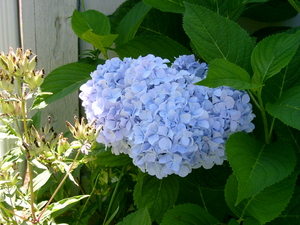Gardenias. Orange trees. Blue Hydrangeas. Azaleas. Blueberries.
There’s a long list of dazzling, delicious plants that must grow in very acid soil. Some weekend gardeners devote entire summers to this chore, just so they can grow those low-pH plants.
Some gardeners seek neutral soil for popular plants. But they live in a region where all the soil is made of seashells by the seashore — sections of Florida, for instance. Although the median pH of Florida soil is 6.1, in some areas it measures 8.5. In certain areas of Arizona where it never rains — the desert – pH can reach 8.5. If you live in Alabama, Mississippi or Tennessee, you grow everything in alkaline Selma Chalk. Or maybe you have over-limed, tilting pH skyward until nothing grows.
Correct soil pH is as necessary to plants as sunlight. Nutrients they need to grow simply won’t dissolve when pH is off. Plants can’t use iron, for instance, in soil with a pH higher than 6.0.
Whatever the reason, when soil pH is too high,it must come down. You have several options. Here they are, with their pros and cons:
1. BATTERY ACID – pH 0.5 to 1.0. Battery acid is 33.5 percent Sulphuric Acid. Some people pour a few cups into a garbage can and fill with water, then use that to irrigate. Others pour directly onto the soil, then water overnight. Readings should drop immediately to a low of 3.5 4.5 pH. One-half teaspoon of battery acid stirred into a gallon of a water with a neutral pH will read 5 or 6 ph. Use routinely, and always with a pH meter. Pros: Fast; just add water. Cons: Corrosive, therefore risky.
2. FLOWERS OF SULPHUR – Mixed into soil, Flowers of Sulphur — sometimes called “Elemental Sulphur” — works by feeding sulphur-eating bacteria. Microbes metabolize the S and deposit sulphuric acid as a biproduct. Voila! pH plummets. Pros: It works. Cons: You need air, warmth, and moisture to keep the bacteria cooking. You also need patience; this method can take a year to work. Also, it does not work in soil with free carbonates. Warning: Do not substitute a sulphite fertilizer, SO4-2; those molecules will not change the pH.
3. PEAT MOSS – Mixed into soil in generous ratios, Sphagnum Peatmoss causes pH to plunge over time. Compost and manure also lower pH. 2 1/2 lbs of Peatmoss will reduce the pH of 1 sq. yd of soil by 1.
4. ORANGE JUICE – pH 3.4 to 4.0. Lemonade (pH around 3.8). Distilled White Vinegar (2.4). Apple Cider Vinegar (4.3 to 5.0). Stale Coffee (5.0). Coca-Cola (2.5). Dilute with water in a ratio of 2 parts Acid to 1 part neutral water until you have the reading you want. The effect is only temporary, but it’s better than nothing. Pros: Convenient and organic. Cons: These organic acids are short-lived anions; before you know it, pH rises again.
5. IRON SULPHATE – Pros: Works faster than Sulphur. Cons: You need a lot. And it takes months to work.
6. ALUMINUM SULFATE – Fertilizing with (NH4)2SO4 lowers pH over time via chemical reaction, forming sulphuric acid as it breaks down in the soil. Pros: It works. Cons: Takes time.








